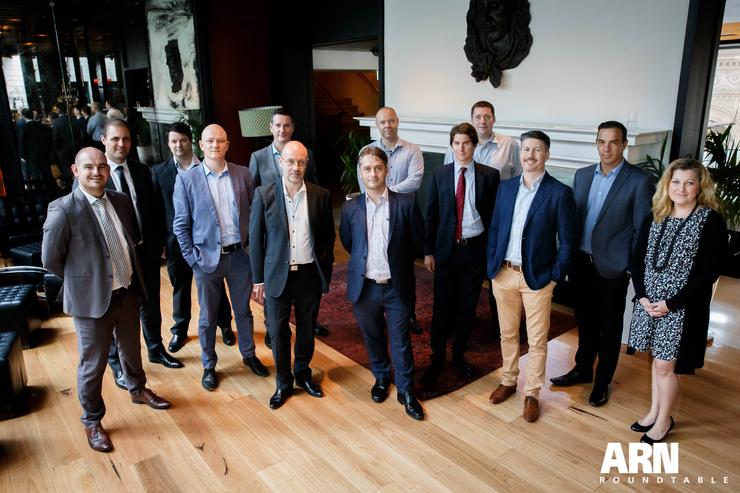
James Henderson (ARN); James Ormesher (VMtech); Rhys Shannon (Westcon-Comstor); Cornelius Mare (Fortinet); Steve Rutter (Staples); James King (Fujitsu); Denis Valente (Exclusive Networks); Richard Tomkinson (Cloudten Industries); Matthew Kates (Zerto); Iain Elliott (Viatek Technology); Jamie Warner (eNerds); Nathan Steiner (Veeam) and Marina Brook (StorageCraft)
For Mare, placing workloads in the cloud does not require a security trade- off, more so a need to understand the exact implications on an organisation from a data standpoint.
New IT influencers
As the market enters the second wave of cloud, the influencers within it are also starting to change, with the CIO no longer the standard- bearer of IT.
Instead, as consumer behaviour infiltrates the workplace, coupled with changing user expectations, pockets of new buyers in the enterprise are emerging.
The result is an increase in technology spending funded by non-IT business units, which is expected to reach US$609 billion in 2017, as every budget becomes a technology budget.
“We find that the bigger the customer and the bigger the corporate entity, because it is so easy to run workloads in the cloud, different departments are beginning to stand up their own projects,” Cloudten industries principal infrastructure architect Richard Tomkinson said.
Representing an increase of 5.9 per cent over 2016, IDC research points to a changing buying landscape for the channel, one which sees line of business (LOB) leaders gain greater control of the technology buying process.
“But there’s no central governance,” Tomkinson cautioned. “Instead, what happens is multiple departments deploying different tools here and there. This might be great for a particular department at a particular time but for the benefit of the organisation, and in a cloud context, a more central approach is required.
“Users are heavily constrained by what they can do on-premise so they take their credit card and spin up a workload in the cloud.”
Originating from a desire to digitise operations, changing competitive landscapes and consumerism are disrupting businesses and creating an imperative to invest in digital transformation.
Consequently, partners are now faced with a new breed of buyer in the cloud, a buyer not bound by CIO tendencies and not tied to legacy decisions of the past.
“The move to cloud used to be more of a lift and shift approach, but now that approach has changed,” Fujitsu solutions director — cloud portfolio James King explained. “We used to sell to the CIO but now we’re selling to the business and those business units are driving cloud spend which creates a new dynamic in the channel.
“In 2016, more than half of the outsourcing contact decisions made worldwide were made outside of the IT department which represents a huge shift in buying patterns.”

As a result, King said the cloud sell is changing, as customers seek consultative services over transactional deals.
“It’s more focused on smaller consulting engagements where you engage with a customer to solve a smaller problem,” he said. “It’s a shift away from being a technology seller and pitching the features of the product to win large chunky deals.
“Now the industry is moving towards small business focused discussions. It’s a different process for partners and because of that we’re competing more with traditional consulting companies.”
By 2020, LOB technology spending is expected to be nearly equal to that of the IT organisation, placing business units in the frontline of the cloud and digital transformation strategies.
Consequently, traditional providers that do not have a strategy to offer cloud based services face challenges ahead, with the onus to evolve business models and create differentiated offerings in a competitive marketplace.
“We’re seeing our competitors under pressure,” Ormesher said. “The kit side of the market is deteriorating and partners are struggling to adapt. We’ve successfully made that transition because we spotted the opportunity a number of years ago and directed our efforts towards managed services to boost our annuity revenue streams.
“But some parts of the channel are pushing hard on hardware, when it might not be relevant anymore. Likewise however, born-in-the-cloud providers are pushing hard on public cloud sales when that equally might not be relevant.
“There’s a balancing act required. Today, customers are less bothered by the technology or the brand under the covers.”
As the forces of cloud, social, mobile and information reconfigure how people work and live, the channel is now aligning with vendors capable of capitalising on such change, addressing the fluctuating demands of the customer in the process.
“If you think about the cloud conversations taking place today, it’s about solutions,” Westcon-Comstor director of cloud and service solutions A/NZ Rhys Shannon added. “The beauty of cloud is in its simplicity but traditional vendors still approach cloud in a complex manner, through the way it is ordered, processed, measured and tracked.
“It’s a complex undertaking and the industry as a whole hasn’t figured out how to make things simple.”
Selling cloud
To create value in the cloud, partners are required to understand business opportunities in new ways, with a need to step away from traditional methods in favour of an outcome- focused approach.

“If customers understand the reason why they are moving to the cloud, then it presents an opportunity to discuss the security aspect of the migration,” Mare advised. “But the channel must be able to articulate the benefit of cloud because customers must understand the growth potential and build a suitable strategy around that.”
As a vendor, Mare said technology manufacturers must work with channel partners to help demonstrate the value of cloud, detailing the pros and cons from an outcome perspective to trigger end- user adoption.
“How can partners help?” he asked. “They can show the compelling reason for businesses to change and adopt cloud because being aware of the risks is key from an education standpoint.”
While cloud uptake is accelerating across all aspects of the market, selling differs from small and medium businesses (SMB) to the enterprise, with business owners seeking advice and guidance along the way.
“As an MSP focusing on the SMB market, ultimately you don’t have a product,” eNerds CEO, Jamie Warner, said. “You’re a service provider that has multiple vendor products that formulate a solution.”
Primarily, Warner said MSPs are selling “piece of mind” in the cloud, rather than pursuing archaic sales processes.
“When you knock on the door and say to the customer that I’m better than the other provider, you’re relying on relationships,” he explained. “Alternatively, you can come in and say that you understand their business and that you can see they are operating in the old way.
“Then you can demonstrate how the customer can take advantage of the latest cloud technologies and it’s a conversation they will have. SMBs want to hear your vision for the future rather than just coming in and simply taking over the last provider.”
But despite the new techniques required by partners when selling cloud technologies, old habits continue to creep into the channel process, with resellers continuing to rest on old laurels.
“There’s still a tendency to want to do the same as we have done before but do it slightly better,” King said. “But the customer wants something entirely different.
“The channel is now challenged to move away from the mindset of focusing on incremental improvement to looking at an entirely different way of doing things.”
Citing the example of Amazon Web Services (AWS), King said that because the cloud giant started out as a book seller rather than an IT vendor, it wasn’t bogged down by the baggage of past decisions.




